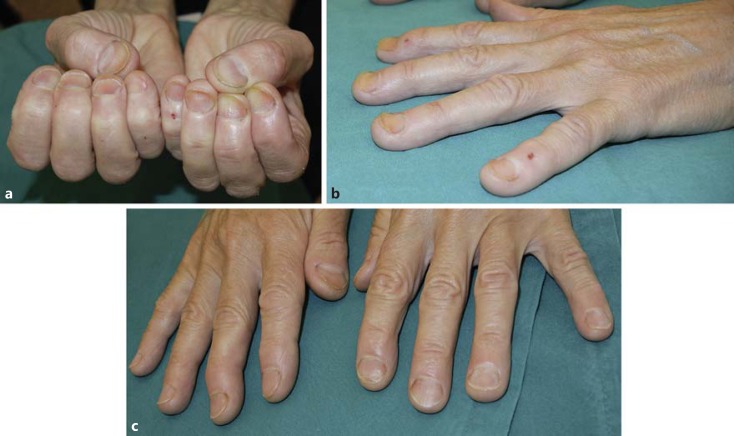Dear Sir,
Koilonychia (spoon-shaped nails) is characterized by the reversion of the curvature in the transverse and longitudinal axes of the nail plate. The lateral edges become upwards everted and the nail appears thinner and concave, giving rise to the typical “spoon” shape [1,2].
An 80-year-old woman presented with an acute onset of koilonychia and yellow-reddish discoloration of all fingernails (Fig. 1a, b). The sudden occurrence was cause of concern for the patient and prompted her to seek medical advice.
Fig. 1.
a Clinical presentation of koilonychia and pigmentation of all fingernails. b Lateral view highlighting the curvature. c Complete healing after 3 months.
Her medical history was unremarkable for systemic or cutaneous diseases, and she denied any medication at the time of our consultation; however, she reported direct contact with wet ivy ash 2 days earlier, having cut the ivy and then burnt it to use as fertilizer. Unfortunately, after a few days of rain, the patient decided to collect it with her bare hands. The following morning, the nail plates of all her fingernails presented a yellow pigmentation and were curved in the classic spoon-shaped appearance, typical of koilonychia. We hypothesized that the ash and water produced an alkaline substance, namely lye, which thinned and softened the nail plates, making them easily deformable.
We prescribed the daily application of a nail lacquer made of a hydroalcoholic extract (Equisetum arvensis), which is on sale in Italian drugstores, to harden the nail plate. In addition, we advised the patient to avoid contact with irritating substances as well as trauma. After 3 months, the clinical manifestation completely resolved (Fig. 1c).
Normally, the nail is firmly attached to bone by vertical dermal connective tissue bundles in the subungual area, which bond directly to the periosteum. Koilonychia is most frequently due to local rather than systemic factors (Table 1). Occupational koilonychia is often associated with mild nail plate surface abnormalities and nail plate discoloration/pigmentation [1,2].
Table 1.
Common causes of koilonychia
| Idiopathic | |||||
| Physiological | Early childhood | ||||
| Congenital | LEOPARD syndrome | ||||
| Ectodermal dysplasias | |||||
| Trichothiodystrophy | |||||
| Nail-patella syndrome | |||||
| Acquired | Metabolic/endocrine | Acromegaly | |||
| Hemochromatosis | |||||
| Iron deficiency | |||||
| Porphyria | |||||
| Renal dialysis/transplant | |||||
| Thyroid disease | |||||
| Dermatoses | Alopecia areata | ||||
| Darier disease | |||||
| Lichen planus | |||||
| Psoriasis | |||||
| Raynaud disease | |||||
| Exogenous | Occupational | ||||
| Traumatic | |||||
| Infections | Onychomycosis | ||||
| Syphilis | |||||
| Carpal tunnel syndrome | |||||
Lye, properly known as potassium hydroxide (KOH), is an alkaline solution obtained by leaching ashes (largely containing potassium carbonate). The role of KOH in dermatology is well known, being used in higher concentration to dissolve keratin in mycological examination or in lower concentration as a softener for nail grooves.
Lye can be produced both via warm or cold method. In the cold method, ash and water are conserved for days in a container and mixed daily, allowing the caustic salt of the ash to be released (the more mixture is mixed, the longer the contact and the more the solution will be caustic). Koilonychia due to alkali has been reported in cement workers/bricklayers [2,3]. In our case, the contact between ash and water lasted only a few days, so the lye was not powerful; however, the direct contact with the alkaline substance determined the loss of consistency of the nail plate, which was deformed because of the traction exerted by the nail bed, becoming spoon-shaped.
Statement of Ethics
Written consent has been obtained from the patient. The authors have no ethical conflicts to disclose.
Disclosure Statement
The authors have no conflicts of interest to disclose.
References
- 1.Baran R, Dawber RPR, Haneke E, Tosti A, Bristow I. A Text Atlas of Nail Disorders. London: Taylor & Francis; 2005. Nail configuration abnormalities; pp. 15–18. [Google Scholar]
- 2.Walker J, Baran R, Velez N, Jellinek N. Koilonychia: an update on pathophysiology, differential diagnosis and clinical relevance. J Eur Acad Dermatol Venereol. 2016;30:1985–1991. doi: 10.1111/jdv.13610. [DOI] [PubMed] [Google Scholar]
- 3.Hagman JH, Ginebri A, Mordenti C, De Simoni I, Chimenti S. Treatment of occupational koilonychia with tazarotene gel. Acta Derm Venereol. 2003;83:296–297. doi: 10.1080/00015550310016607. [DOI] [PubMed] [Google Scholar]



